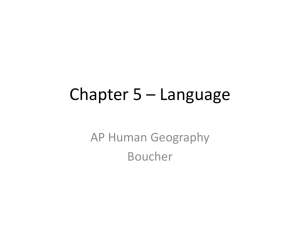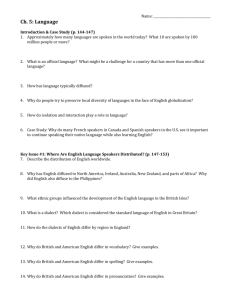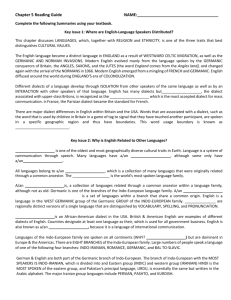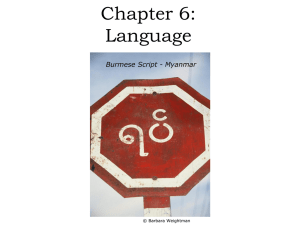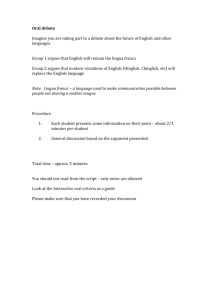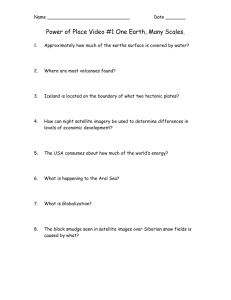Official language - Bloomer School District
advertisement
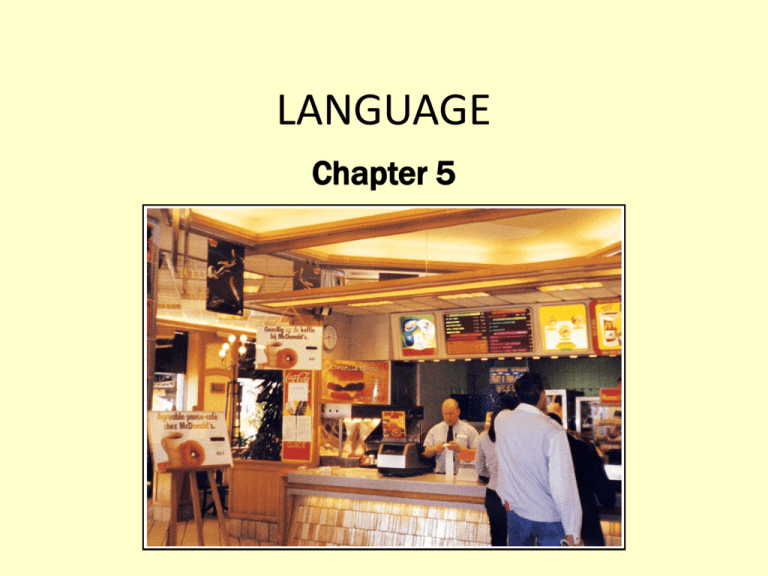
LANGUAGE Chapter 5 What Are Languages, and What Role Do Languages Play in Culture? • Language: A set of sounds, combinations of sounds, and symbols used for communication • Standard language: A language that is published, widely distributed, and purposefully taught • Role of government in standardizing a language Language and Culture “No one was allowed to speak the language – the Dena’ina language. They [the American government] didn’t allow it in the schools, and a lot of the women had married non-native men, and the men said, ‘You’re American now so you can’t speak the language.’ So, we became invisible in the community. Invisible to each other. And, then, because we couldn’t speak the language – what happens when you can’t speak your own language is you have to think with someone else’s words, and that’s a dreadful kind of isolation [emphasis added].” - Clare Swan, elder, Kenaitze band, Dena’ina Indians 1. What was the purpose of policies like this? Were they effective? 3 The Internet: Globalization of Language 2. What effect will the internet have on language going into the future? Language and Politics 3. What language do you think is spoken in those dark blue areas? What are the political implications? Non-English Speakers Political issue of speakers of Spanish and other languages vs. those desiring English only? Language and Cultural Identity 7 • Federal level: • officially bilingual • Provinces: – Quebec• officially French – New Brunswick – • only province officially bilingual – Other provinces • officially English Quebec vs. Canada 8 Mutual Intelligibility • Isogloss: A geographic boundary within which a particular linguistic feature occurs • Criterion for a language: Speakers can understand each other – Problems • Measuring “mutual intelligibility” • Standard languages and government impact on what is a “language” and what is a “dialect” – Dialect: variant of standard language by ethnicity or region • Vocabulary • Syntax 4. What is Syntax? • Cadence, pace • Pronunciation English Speaking Countries Fig. 5-1: English is the official language in 42 countries, including some in which it is not the most widely spoken language. It is also used and understood in many others. 10 The Queens English • A dialect is a regional variation of a language distinguished by distinctive vocabulary, spelling, and pronunciation. • English has an especially large number of dialects. • One particular dialect of English, the one associated with upper-class Britons living in the London area, is recognized in much of the Englishspeaking world as the standard form of British speech, known as British Received Pronunciation (BRP). 11 Differences between British and American English • The earliest colonists were most responsible for the dominant language patterns that exist today in the English-speaking part of the Western Hemisphere. 12 Differences in Vocabulary and Spelling • • • • • • • English in the United States and England evolved independently (Isolation) during the eighteenth and nineteenth centuries. U.S. English differs from that of England in three significant ways: vocabulary, spelling, and pronunciation. The vocabulary is different because settlers in America encountered many new objects and experiences, which were given names borrowed from Native Americans. As new inventions appeared, they acquired different names on either side of the Atlantic. Spelling diverged because of a strong national feeling in the United States for an independent identity. Noah Webster, the creator of the first comprehensive American dictionary and grammar books, was not just a documenter of usage, he had an agenda. Webster argued that spelling and grammar reforms would help establish a national language, reduce cultural dependence on England, and inspire national pride. 13 Differences in Pronunciation • Differences in pronunciation between British and U.S. speakers are immediately recognizable. • Interaction between the two groups was largely confined to exchange of letters and other printed matter rather than direct speech. • Surprisingly, pronunciation has changed more in England than in the United States. • People in the United States do not speak “proper” English because when the colonists left England, “proper” English was not what it is today. 14 British Slang Words Below are a few slang words commonly used in Britain. • • • • • • • • • Bloke - man. 'John is a nice bloke to know.' Botched - poor quality repairs. 'He made a botched job of fixing the television.' Bottle - courage. 'He doesn't have the bottle to ask her.' Cheesed Off - fed up Chuck it down - to rain, often heavily. 'It is going to chuck it down soon.' Chuffed - If you are chuffed, you are happy with something. 'I was chuffed to win a medal!' Daft - Crazy / stupid Dosh - Money / cash 'I haven't got much dosh to give you.' Gobsmacked - Incredibly amazed. 'I was gobsmacked when I saw my birthday presents.' • • • • • • Gutted - Not happy because of an event that has occurred that didn't go your way. 'I was gutted when I didn't win the race' Jammy - Used in place of lucky when describing someone else. 'He was very jammy winning the lottery'. Scrummy - Delicious. Shortened from scrumptious. 'The food was very scrummy' Skint - Broke. No money. 'I'm skint, I wont be able to buy the DVD today.' to Snog - to long kiss Telly - Television 'I watched the news on the telly last night.' 15 Dialects in the United States • • • • • Major differences in U.S. dialects originated because of differences in dialects among the original settlers. The original American settlements can be grouped into three areas: New England, Middle Atlantic, and Southeastern. Two-thirds of the New England colonists were Puritans from East Anglia in southeastern England. About half of the southeastern settlers came from southeast England, although they represented a diversity of social-class backgrounds. The immigrants to the Middle Atlantic colonies were more diverse because most of the settlers came from the north rather than the south of England or from other countries. 16 Dialects in the Eastern U.S. Fig. 5-4: Hans Kurath divided the eastern U.S. into three dialect regions, whose distribution is similar to that of house types (Fig. 4-9). 17 Minor Dialects Today 18 Example of Dialect What American Do You Speak? http://www.alphadictionary.com/articles/yankee test.html Provide a summary of your results. http://www.pbs.org/speak/seatosea/officialamer ican/ Should the Us have an official Language? Explain Why or why not? http://popvssoda.com:2998/ Report your results Stop Here: Complete dialects and language patterns activities for Thursday. 20 Standard and Variant Languages • Standard Language? – Came from the dialect of the most powerful and prestigious • Dialects? Soda or Pop? – Social dialects? – Vernacular language? – Geographic or regional dialects? • Linguistic geography? - Isogloss? • Pidgins and Creoles – Amalgam of languages – Simplified form Spanglish Spanglish Song Runglish – Creole language is a pidgin language with a more complex structure and vocabulary that has become the native language of a group of people. Cajun Standard and Variant Languages • Lingua Franca – A lingua franca is a language used among speakers of different languages for the purposes of trade and commerce. Standard and Variant Languages Multilingualism • Monolingual states are countries where almost everyone speaks the same language. Ex.: Japan, Uruguay, Iceland, Denmark, Portugal, Poland, Lesotho • Countries in which more than one language is in use are called multilingual states. Language, Territoriality, and Identity • Recognition and Autonomy Insert figure 5.15 © Barbara Weightman Photo by Mark Bjellend Language, Territoriality, and Identity Official Languages • Countries with linguistic fragmentation often adopt an official language (or languages) to tie the people together. • A State adopts an official language in the hope of promoting communication and interaction among peoples who speak different local and regional languages. • The official languages in a country are a reflection of the country’s history. Should the U.S. adopt an official Language? Quebec and Pop 25 Why Are Languages Distributed the Way They Are? Classification by language families (groups of related languages) Major World Languages Language Family Major Language Numbers (in millions) Indo-European English 445 Hindi 366 Spanish 340 Chinese 1,211 Burmese 32 Japanese 125 Korean 78 Afro-Asiatic Arabic 211 Malay-Polynesian Indonesian 154 Dravidian (India) Telugu 69 Altaic Turkish 61 Sino-Tibetan Japanese-Korean 28 Language Formation • Linkages among languages marked by sound shifts slight changes in a word across languages over time – allow us to trace the evolution of language Milk = lacte in Latin lait in French leche in Spanish latta in Italian • Language divergence: Breakup of a language into dialects and then new languages from lack of interaction among speakers • Language convergence: When peoples with different languages have consistent interaction and their languages blend into one • Language divergence: Breakup of a language into dialects and then new languages from lack of interaction among speakers. The further from Britain the more divergent the phrase Language Formation • Language convergence: When peoples with different languages have consistent interaction and their languages blend into one Remember the “Spanglish” Song? The Study of Historical Languages Backward reconstruction: Tracking sound shifts and the hardening of consonants backward to reveal an “original” language • Can deduce the vocabulary of an extinct language • Can recreate ancient languages (deep reconstruction) Historical Linkages among Languages • Indo-European language family • Proto-Indo-European language • Nostratic Language (ancient ancestor of Proto-Indo-European Language) Origins of Proto-Indo-European Renfrew Hypothesis: Began in the Fertile Crescent, and then • Europe’s languages from Anatolia • North Africa and Arabia’s languages from the Western Arc of Fertile Crescent • Southwest Asia and South Asia’s languages from the Eastern Arc of Fertile Crescent • How do we know? Convergence and divergence indicates a spatial pattern. Agriculture Theory of Westward Dispersal With increased food supply and population, migration of speakers from the hearth of Indo-European languages into Europe A different point of origin? The Dispersal Hypothesis • From the hearth eastward into present-day Iran • Around the Caspian • Into Europe The Languages of Europe Almost (Basque is the outlier) all European languages fall under the Indo-European language Family. The three European sub-groups are: • Romance languages • Germanic languages • Slavic languages Major Indo-European Branches •Germanic •Romance •Slavic Other Indo-European •Celtic •Baltic •Hellenic •Thracian/Ilyrian •Other Families •Finno-Ugric •Samoyedic •Altaic •Other? – Basque? 39 Germanic Branch - English Diffused throughout the world by hundreds of years of British colonialism. Brought to New World by British colonies in 1600s. Has become an important global lingua franca. 40 Why “Indo”- European?? Indo-European Language Family Fig. 5-5: The main branches of the Indo-European language family include Germanic, 42 Romance, Balto-Slavic, and Indo-Iranian. India • 4 language families – only Indo-European & Dravidian have a significant number of speakers. 43 Germanic Branch of Indo-European • • English and German are both languages in the West Germanic group. West Germanic is further divided into High Germanic and Low Germanic subgroups, so named because they are found in high and low elevations within present-day Germany. – High German, spoken in the southern mountains of Germany, is the basis for the modern standard German language. – English is classified in the Low Germanic subgroup. – The Germanic language branch also includes North Germanic languages, spoken in Scandinavia. – The four Scandinavian languages—Swedish, Danish, Norwegian, and Icelandic—all derive from Old Norse. Fig. 5-6: The Germanic branch today is divided into North and West Germanic 44 groups. English is in the West Germanic group. Indo-Iranian Branch of Indo-European The branch of the Indo-European language family with the most speakers is Indo-Iranian, more than 100 individual languages divided into an eastern group (Indic) and a western group (Iranian). 45 Indic (Eastern) Group of Indo-Iranian Language Branch • The most widely used languages in India, as well as in the neighboring countries of Pakistan and Bangladesh, belong to the Indic group of the Indo-Iranian branch of IndoEuropean. • Approximately one-third of Indians, mostly in the north, use an Indic language called Hindi. • Hindi is spoken many different ways—and therefore could be regarded as a collection of many individual languages but there is only one official way to write the language, using a script called Devanagari. 46 Pakistan • Pakistan’s principal language, Urdu, is spoken very much like Hindi but is written with the Arabic alphabet, a legacy of the fact that most Pakistanis are Muslims, and their holiest book (the Quran) is written in Arabic. • Hindi, originally a variety of Hindustani spoken in the area of New Delhi, grew into a national language in the nineteenth century when the British encouraged its use in government. 47 South Asian Languages and Language Families Fig. 5-7: Indo-European is the largest of four main language families in South Asia. 48 The country of India has 18 official languages. Iranian (Western) Group of IndoIranian Language Branch • Indo-Iranian languages spoken in Iran and neighboring countries form a separate group from Indic. • The major Iranian group languages include Persian (sometimes called Farsi) in Iran, Pathan in eastern Afghanistan and western Pakistan, and Kurdish, used by the Kurds of western Iran, northern Iraq, and eastern Turkey. • These languages are written in the Arabic alphabet. 49 Balto-Slavic Branch of Indo-European • Slavic was once a single language, but differences developed in the seventh century A.D. when several groups of Slavs migrated from Asia to different areas of Eastern Europe. 50 East Slavic and Baltic Groups of BaltoSlavic Language Branch • After Russian, Ukrainian and Belarusian (sometimes written Byelorussian) are the two most important East Slavic languages. • The desire to use languages other than Russian was a major drive in the Soviet Union breakup a decade ago. 51 West and South Slavic Groups of BaltoSlavic Language Branch • The most spoken West Slavic language is Polish, followed by Czech and Slovak. • The latter two are quite similar, and speakers of one can understand the other. • The two most important South Slavic languages are Serbo-Croatian and Bulgarian. • Although Serbs and Croats speak the same language, they use different alphabets. • Slovene is the official language of Slovenia, while Macedonian is used in the former Yugoslav republic of Macedonia. 52 Romance Branch of Indo-European Fig. 5-8: The Romance branch includes three of the world’s 12 most widely spoken languages (Spanish, French, and Portuguese), as well as a number of smaller languages and dialects. 53 Isolated Languages • An isolated language is a language unrelated to any other and therefore not attached to any language family. • Isolated languages arise through lack of interaction with speakers of other languages. 54 A Pre-Indo-European Survivor: Basque • The best example of an isolated language in Europe is Basque. • Basque is spoken by 1 million people in the Pyrenees Mountains. 55 The Case of Euskera Spoken by the Basque and in no way related to any other language family in Europe An Unchanging Language: Icelandic • Unlike Basque, Icelandic is related to other languages. • Icelandic’s significance is that over the past thousand years it has changed less than any other in the Germanic branch….WHY? 57 Languages of Subsaharan Africa • Dominant language family: Niger-Congo – Relatively recent migration – Continued recognizable similarities among subfamilies • Displacement of Khoisan family, now in southwestern Africa • More than 400 languages • Nigeria a colonial creation • Choice of English as “official” language rather than any indigenous language Nigeria Nigeria • What is the problem with Nigeria and language?? How Do Languages Diffuse? • • • • • • Human interaction Print distribution Migration Trade Rise of nation-states Colonialism Elizabeth J. Leppman IT….How will the internet affect language diffusion and convergence? Effects of Spatial Interaction • Lingua franca: A language used among speakers of different languages for trade and commerce • Pidgin language: A language created when people combine parts of two or more languages into a simplified structure and vocabulary • Creole language: A pidgin language that has developed a more complex structure and vocabulary and has become the native language of a group of people Multilingualism • Monolingual state: A country in which only one language is spoken • Multilingual state: A country in which more than one language is in use • Official language: Government-selected language or languages to try to enhance communication in a multilingual state Global Language • English as lingua franca for – Commerce – Science – Travel – Business – Popular culture • Continued use of native languages for dayto-day activities English: An Example of a Lingua Franca • • • • • A language of international communication (internet) is known as a lingua franca. The term, which means language of the Franks, was originally applied by Arab traders during the Middle Ages to describe the language they used to communicate with Europeans, whom they called Franks. A group that learns English or another lingua franca may learn a simplified form, called a pidgin language. Two groups construct a pidgin language by learning a few of the grammar rules and words of a lingua franca, while mixing in some elements of their own languages. Other than English, modern lingua franca languages include Swahili in East Africa, Hindustani in South Asia, and Russian in the former Soviet Union. 66 Global Dominance of English • One of the most fundamental needs in a global society is a common language for communication. • Increasingly in the modern world, the language of international communication is English. • When well-educated speakers of two different languages wish to communicate with each other in countries such as India or Nigeria, they frequently use English. 67 Diffusion of English 1. People from England establishing colonizes. 2. Seventeenth century: 1. North America 2. Ireland 3. Eighteenth century 1. South Asia 2. South Pacific, 4. Nineteenth century 1. Southern Africa. 5. More recently, the United States has been responsible for diffusing English to several places. 68 Basis of English • English originated with three invading groups who settled in different parts of Britain. (Anglo’s – Saxon’s - Jutes) • The language each spoke was the basis of distinct regional dialects of Old English. • Convergence results in…English 69 Franglais • The French are particularly upset with the increasing worldwide domination of English. • French is an official language in 26 countries and for hundreds of years served as the lingua franca for international diplomats. • The widespread use of English in the French language is called franglais, a combination of francais and anglais, the French words for French and English. 70 Spanglish • Spanglish is a richer integration of English with Spanish than the mere borrowing of English words. • New words have been invented in Spanglish that do not exist in English but would be useful if they did. • Spanglish has become especially widespread in popular culture, such as song lyrics, television, and magazines aimed at young Hispanic women, but it has also been adopted by writers of serious literature. 71 What Role Does Language Play in Making Places? • Place: The uniqueness of a location, what people do in a location, what they create, how they impart a certain character, a certain imprint on the location • Toponym: A place name – Imparts a certain character on a place – Reflects the social processes in a place – Can give a glimpse of the history of a place The Ten Toponyms • English Professor George Stewart More Toponyms Incidental: Battle Creek Michigan Bloody Ridge MO Cut and Shoot Texas According to one local legend, Cut and Shoot was named after a 1912 community confrontation that almost led to violence. According to differing versions of the story, the dispute was either over: The design of a new steeple for the town's only church, The issue of who should be allowed to preach there, or The conflicting land claims among church members. Whatever the circumstances were, a small boy at the scene reportedly declared "I'm going to cut around the corner and shoot through the bushes in a minute!" This statement apparently stayed in the residents' minds and was eventually adopted as the town's name.[ Still More Toponyms Folk Entymology: These are the toughest to discern. Folk etymology is an example of one group of language speakers mangling the language of an earlier group and then assigning their own “creative explanation for the place name. Examples: Norwalk CT – Comes from the Native American name “naraaswaake” which means “point/penninsula. English speakers couldn’t pronounce it – becomes Norwalk and the explanation is a “northern walking path” Bayou Funny Creek LA – Comes from the Choctaw Name – Bayou (river) Fani (squirrel) Tomahawk, WI – Anishinaabe name Tomkaadakuk, meaning “treaty kettle” – Site of a treaty ceremony Changing Toponyms Major reasons people change toponyms • After decolonization • After a political revolution • To commodify or brand a place • To memorialize people or events What Role Does Language Play in Making Places? Toponyms and Globalization • The toponyms we see on a map depend in large part on who produced the map. • Some embattled locales have more than one name at the same time. • Ex.: Argentineans refer to a small cluster (archipelago) of islands off the southeast coast of South America as the Malvinas, but the British call the same cluster of islands the Falkland Islands. . What Role Does Language Play in Making Places? Changing Toponyms • Postcolonial Toponyms: New governments renamed several countries and newly independent countries also changed the names of cities and towns to reflect their independence. Rhodesia >Zimbabwe • Postrevolution Toponyms: Changes in power through coups and revolutions prompt name changes. Burma ->Myanmar • Memorial Toponyms: People change a toponym to memorialize an important person or event. St. Petersburg -> Stalingrad ->St. Petersburg ACTIVITY: Toponym Road Map (Complete by Monday. Study Guide part 2 by TUESDAY)
